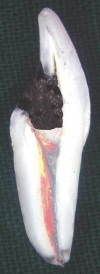Coronal microleakage with five different temporary restorative materials following walking bleach technique: An ex-vivo study
- PMID: 23633802
- PMCID: PMC3636844
- DOI: 10.4103/0976-237X.107431
Coronal microleakage with five different temporary restorative materials following walking bleach technique: An ex-vivo study
Abstract
Context: Walking bleach technique uses 30% hydrogen peroxide and sodium perborate, and this paste mixture causes loosening of the coronal temporary restorative materials and thus decreasing its clinical effectiveness and causing irritation to the patients oral tissues. In the present study, sealing ability of hygroscopic coronal temporary restorative materials were compared with the other commonly used temporary restorative materials.
Aim: To evaluate the effects of walking bleach material on the marginal sealing ability and coronal microleakage of the hydrophilic temporary restorative materials with that of the other commonly used temporary restorative materials in endodontic practice.
Materials and methods: Seventy-five extracted human maxillary central incisor teeth were prepared chemo-mechanically and obturated with gutta-percha in lateral condensation technique. Surface of each tooth was double coated with cyanoacrylate glue. All the teeth were randomly divided in to five groups. Out of 15 teeth in each group, 10 teeth served as experimental specimens, in which bleaching agent was placed in the pulp chamber and 5 teeth served as control, in which no bleaching agent was placed. The access cavities were restored with temporary restorative materials being tested per each group respectively. The specimens were then immersed in 1% India ink dye and subjected to thermo cycling for 7 days. All the teeth were longitudinally sectioned and observed with stereomicroscope and were graded according to the depth of linear dye penetration.
Statistical analysis used: Mann-Whitney U test and Kruskal-Wallis test.
Results: Hydrophilic temporary restorative materials Cavit G and Coltosol F have shown minimal coronal dye leakage with better sealing ability when exposed to walking bleach paste mixture in the dye penetration tests compared to other commonly used temporary restorative materials.
Conclusion: Marginal sealing ability of Cavit G and Coltosol F were not influenced by the effects of bleaching agent compared to other temporary restorative materials used in the study.
Keywords: Bleaching agent; dye leakage; dye penetration; microleakage; sealing ability; walking bleach.
Conflict of interest statement
Figures
Similar articles
-
Coronal Sealing Capacity of Temporary Restorative Materials in Pediatric Dentistry: A Comparative Study.Int J Clin Pediatr Dent. 2017 Apr-Jun;10(2):115-118. doi: 10.5005/jp-journals-10005-1419. Epub 2017 Jun 1. Int J Clin Pediatr Dent. 2017. PMID: 28890608 Free PMC article.
-
Comparative evaluation of sealing ability of four different restorative materials used as coronal sealants: an in vitro study.J Int Oral Health. 2014 Jul;6(4):12-7. J Int Oral Health. 2014. PMID: 25214726 Free PMC article.
-
In Vitro Comparison of Dye Penetration through Four Temporary Restorative Materials.Iran Endod J. 2010 Spring;5(2):59-63. Epub 2010 May 20. Iran Endod J. 2010. PMID: 23130028 Free PMC article.
-
Assessing correlation between different temporary restorative materials for microleakage following endodontic treatment: an in-vitro study.BMC Oral Health. 2024 Dec 19;24(1):1505. doi: 10.1186/s12903-024-05302-6. BMC Oral Health. 2024. PMID: 39702142 Free PMC article.
-
Microleakage of TERM used with sodium perborate/water and sodium perborate/superoxol in the "walking bleach" technique.J Endod. 1998 Oct;24(10):648-50. doi: 10.1016/S0099-2399(98)80147-7. J Endod. 1998. PMID: 10023245
Cited by
-
Evaluation of marginal leakage of different temporary restorative materials in Endodontics.Contemp Clin Dent. 2013 Oct;4(4):472-5. doi: 10.4103/0976-237X.123045. Contemp Clin Dent. 2013. PMID: 24403791 Free PMC article.
-
Antimicrobial activity of a temporary sealant used in endodontic treatment: An in vitro study.Eur J Dent. 2015 Jul-Sep;9(3):411-414. doi: 10.4103/1305-7456.163225. Eur J Dent. 2015. PMID: 26430372 Free PMC article.
-
Importance and methodologies of endodontic microleakage studies: A systematic review.J Clin Exp Dent. 2017 Jun 1;9(6):e812-e819. doi: 10.4317/jced.53604. eCollection 2017 Jun. J Clin Exp Dent. 2017. PMID: 28638561 Free PMC article. Review.
References
-
- Hosoya N, Cox CF, Arai T, Nakamura J. The walking bleach procedure: An in vitro study to measure microleakage of five temporary sealing agents. J Endod. 2000;26:716–8. - PubMed
-
- Popoff DA, Goncalves FS, Ferreira RC, Magalhaes CS, Moreira AN, Mjor IA. Repair of amalgam restorations with conventional and bonded amalgam. An in-vitro study. J Dent Sci. 2010;25:154–8.
-
- De Moor RJ, De Bruyne MA. The long-term sealing ability of AH 26 and AH plus used with three gutta-percha obturation techniques. Quintessence Int. 2004;35:326–31. - PubMed
-
- Spasser HF. A simple bleaching technique using sodium perborate. NY State Dent J. 1961;27:332–4.
-
- Nutting EB, Poe GS. A new combination for bleaching teeth. J South Calif Dent Assoc. 1963;31:289–91.




